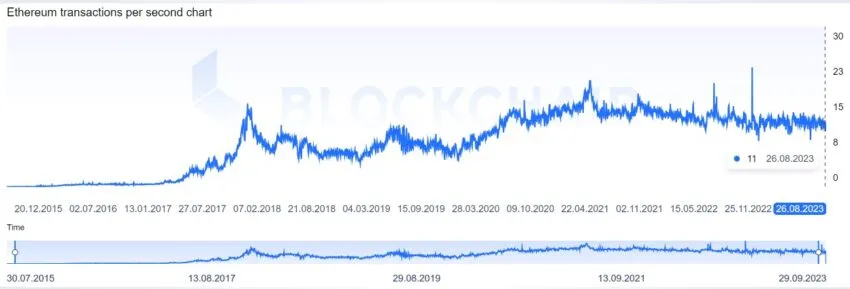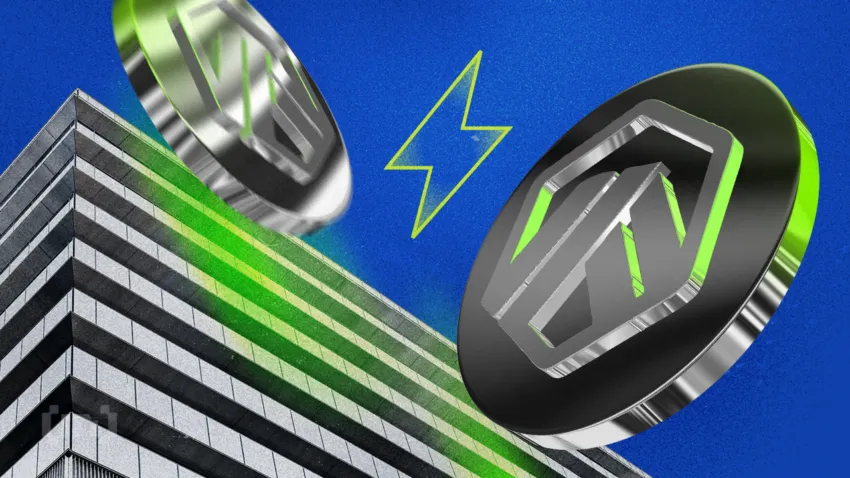Several Ethereum scaling solutions have emerged over the past few years, with Optimism and Arbitrum among the more popular ones. So, which one packs more punch when it comes to making transactions faster, reducing gas fees, and offering a seamless user experience on the Ethereum network? We explore these elements in detail in this comprehensive Optimism vs. Arbitrum comparison.
The backdrop
Ethereum’s brilliance as the leading decentralized layer-1 blockchain for smart contracts and DApps is occasionally clouded by challenges. The biggest challenges it faces include:
- Slow transaction speed
- Low TPS (transaction per second)
- High gas fees (network fees)

In fact, as the number of decentralized applications (DApps) on the network grows, the corresponding surge in activity results in longer transaction times and skyrocketing gas fees.
While Ethereum 2.0 (often referred to as ETH 2.0 or Serenity) is a key upgrade to address Ethereum’s scalability and security challenges, it’s a multi-phase rollout that will take time to implement fully. During this period, the Ethereum network must still support a growing number of DApps and transactions. Layer-2 solutions like Arbitrum and Optimism provide immediate relief by offloading some of the transactional volumes from the main chain.
It is important to note here that while one of the primary advantages of layer-2s for the Ethereum network is easing transaction loads, these solutions also offer several other benefits. For instance, some layer-2 solutions are designed to work seamlessly across multiple blockchains, not just Ethereum. This cross-chain functionality can be advantageous in a multi-chain future. As such, these solutions are likely to remain in demand even after the complete ETH 2.0 rollout.
“Layer-2 is the future of Ethereum scaling and the only safe way to scale Ethereum while preserving decentralization that is so core to the blockchain”
Vitalik Buterin: 2021 Shanghai International Blockchain Week, via BeInCrypto
What is Arbitrum?
Arbitrum, a layer-2 scaling solution, is one of the most trusted L2 platforms on the Ethereum network. Its mission is straightforward: to expedite transactions and cut down costs. Arbitrum is fully integrated with Ethereum and is compatible with the network’s existing smart contracts and DApps.

The platform leverages Optimistic Rollups, a method that bundles transactions, submitting them to the Ethereum mainnet in batches. This approach not only curtails fees but also boosts transaction speeds, enhancing the overall Ethereum experience for users. For those out of the loop, a “rollup” is a scaling solution designed to increase the number of transactions the network can process. It achieves its objective by taking most of the transactional computation off-chain while ensuring the data is still verifiable on-chain.
A significant aspect of Arbitrum is its native ARB crypto, which underpins governance within its ecosystem, allowing for decentralized decision-making.
What is Optimism?
Just like Aribitrum, Optimism is also a Layer 2 scaling solution for the Ethereum blockchain. It aims to resolve the long-standing issue of scalability without compromising security or decentralization.
Similar to Aribtrum, the Optimism solution deploys Optimistic Rollups, which increases throughput by handling most transactions off-chain while utilizing the underlying Ethereum blockchain for security. This approach allows for faster transaction processing and lower fees, significantly enhancing user experience.
The Optimism protocol introduces a unique token, the OP Token, which plays a key role in the network’s operation. It’s used for various purposes within the ecosystem, including paying for transaction fees and incentivizing honest behavior among participants.

Furthermore, Optimism is designed to be fully compatible with Ethereum, meaning that developers can port their decentralized applications to Optimism with little to no modifications. This ease of transition is a significant advantage as it lowers the barriers for developers and encourages the adoption of this layer2 solution.
Moreover, Optimism’s approach to scaling is expected to play a pivotal role in Ethereum’s transition to Ethereum 2.0, which aims to solve the scalability trilemma – achieving a balance among decentralization, security, and scalability.
Optimism vs. Aribitrum: What makes them similar?
Both Arbitrum and Optimism serve as layer 2 rollups for Ethereum. They primarily aim to:
- Redirect most of the main chain’s activity to an off-chain layer 2.
- Engage with the main chain’s smart contract to manage withdrawals/deposits and confirm off-chain operations.
Both rollups must always ensure the authenticity of the off-chain data. Apart from that, Arbitrum and Optimism share further similarities, such as:
- Fraud proofs: These are efficient for scaling as they activate only when false blocks are identified, conserving the network’s computational power.
- Instant finality: Transactions get settled as soon as a block is formed, bypassing multiple confirmations, leading to a swift, efficient network.
- Cross-chain bridges: They facilitate token transfers between layer-1 and layer-2.
While both Optimistic rollups and Arbitrum significantly reduce ETH gas costs, they differ in their proof verification methods and how they address potential compatibility challenges.
Optimism vs. Aribitrum: What sets them apart?

Arbitrum and Optimism, while both layer-2 solutions for Ethereum, have distinct characteristics and functionalities. The Optimism team pioneered the concept of rollups, and later, the Arbitrum team modified this foundation, leading to two different solutions.
The fraud-proof showdown
Let’s imagine a scenario — one in which you’re trying to spot a mistake in a book. Optimism’s approach is like reading the entire book in one go, hoping to catch the error. It uses a single-round fraud-proof, which means it leans on Ethereum (L1) to process the entire L2 transaction. It’s quick, but it’s like using a sledgehammer to crack a nut — it costs more gas, and the L2 fee is bound by the L1 gas block.
Arbitrum, on the other hand, is like using a magnifying glass to examine each page closely. It employs multi-round fraud proofs, zeroing in on specific transaction disagreements. This method is more efficient, and since L2 transactions aren’t wholly executed on L1, the gas block limit doesn’t tie it down.
Ethereum ties and virtual machines (VMs)
Both Arbitrum and Optimism are trusty sidekicks to Ethereum, relying on its validators for honest transaction processing. But here’s what differentiates them — Optimism utilizes Ethereum’s Ethereum Virtual Machine (EVM). This means any significant change in Ethereum could lead to divergent outcomes in Optimism.
Arbitrum, however, marches to its own beat with its Arbitrum Virtual Machine (AVM). DApps from EVM get automatically translated to AVM. That’s like having your own custom-made suit — it fits just right, giving Arbitrum full control. Additionally, while Optimism is limited to the Solidity compiler for OVM bytecode, Arbitrum supports various EVM languages.
Bridges and tokens
Arbitrum and Optimism both feature bridges to interact with other blockchains. Arbitrum offers a universal bridge accessible to all tokens, whereas Optimism creates specific bridges based on market demands.
Let’s put it this way — think of two cities, each with its own bridge. Both Arbitrum and Optimism have bridges to connect with other cities (other blockchains). But while Arbitrum has a grand bridge open to all vehicles, Optimism builds specific bridges based on traffic needs.
Lastly, when it comes to currency, Optimism uses Wrapped ETH (WETH), kind of like exchanging your dollars for tokens at an arcade. It’s pegged to ETH, ensuring smooth cross-chain token movement. Arbitrum, however, directly accepts ETH, skipping the token exchange counter altogether.
Optimism vs. Arbitrum: Which layer-2 solution is better?
Based on every aspect considered in this Optimism vs. Arbitrum comparison, it is evident that both stand out as potent Ethereum enhancers. They both do a neat job adding value to the network. While Arbitrum currently leads in adoption metrics, Optimism boasts a richer feature set, highlighted by its unique Optimism Bridge. Your preference between the two ultimately depends on your distinct requirements. But if you aim to partake in the broader Ethereum ecosystem without the drag of sluggish transactions and hefty fees, both platforms ultimately deserve a spot on your radar.
Frequently asked questions
Is Arbitrum the same as Optimism?
What are the disadvantages of Arbitrum?
Is Arbitrum better than Polygon?
Disclaimer
In line with the Trust Project guidelines, the educational content on this website is offered in good faith and for general information purposes only. BeInCrypto prioritizes providing high-quality information, taking the time to research and create informative content for readers. While partners may reward the company with commissions for placements in articles, these commissions do not influence the unbiased, honest, and helpful content creation process. Any action taken by the reader based on this information is strictly at their own risk. Please note that our Terms and Conditions, Privacy Policy, and Disclaimers have been updated.




